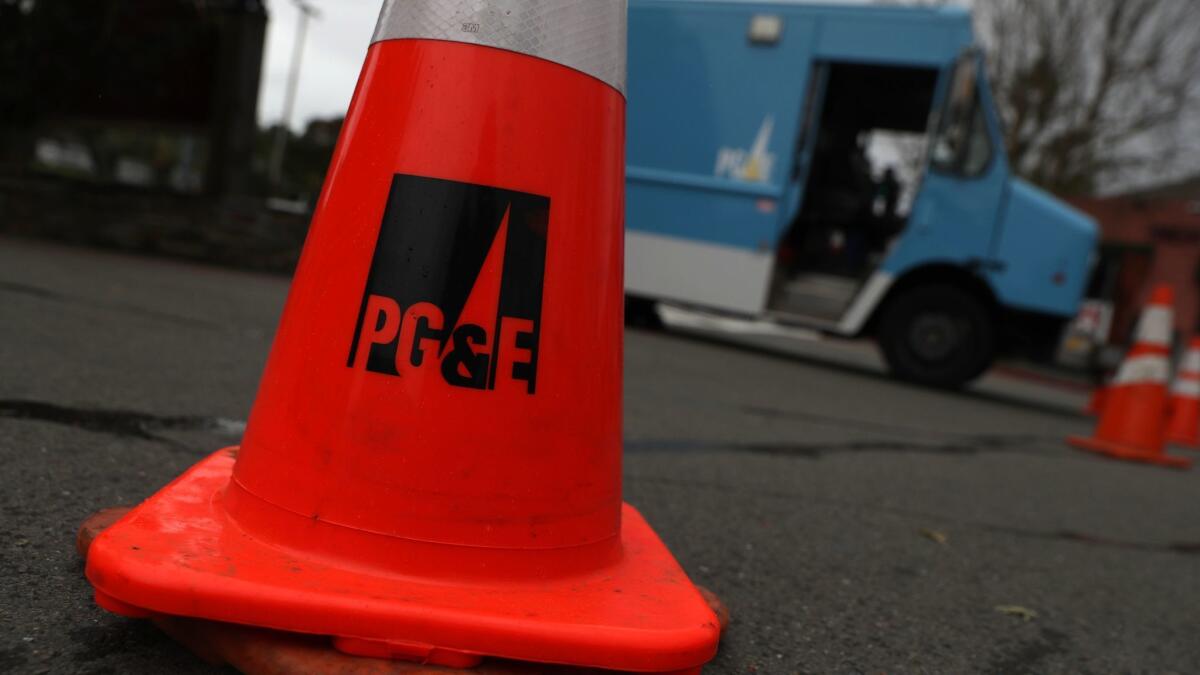California has power over PG&E. Use it

- Share via
After Pacific Gas & Electric, the state’s largest power company, bungled its rollout of so-called public safety power shutoffs earlier this year, Gov. Gavin Newsom blasted the company for its mismanagement, lack of preparation and years of “corporate greed” that left its power lines so unsafe that the only way to avoid burning down communities was to turn off people’s power.
Newsom was right to be mad then — and he’s right to be mad now. PG&E has blatantly ignored demands for accountability and structural change even though the governor and the state Legislature have spent a year making it crystal clear what the investor-owned utility needs to do to be allowed to continue to provide power when it emerges from bankruptcy next year.
Perhaps PG&E officials assumed that was a lot of bluster or that once the rains came the public and the governor would forget to be angry with the power company for causing so many wildfires. Perhaps they thought we’d all move on to other things. After all, even with its shamefully long history of sparking fires and explosions that burn down private property, blow up neighborhoods and kill people, the power company had thus far managed to escape any real threat to business as usual or to its bottom line. Not even the criminal conviction the company got for the safety violations that led to the San Bruno gas pipeline explosion in 2010 resulted in any serious consequences.
So it was a bit of a pleasant shock on Friday when Newsom thoroughly rejected PG&E’s bankruptcy plan with, in effect, an “Um, no.”
In a letter to PG&E Chief Executive William Johnson, Newsom said the corporate restructuring proposed as part of the utility’s $13.5-billion settlement and bankruptcy plan fails to comply with the requirement of Assembly Bill 1054 that the company provide safe, affordable, reliable power, that it make a serious commitment to safety investments and that it do so in a way that is cost-neutral to ratepayers. The law, passed by the Legislature earlier this year, created the $21-billion wildfire fund that will help participating utilities pay for future wildfire liability. Tens of billions in liability costs for the Camp fire and others forced PG&E to seek Chapter 11 protection earlier this year, and its future viability relies on participating in the wildfire fund.
Furthermore, Newsom said any restructuring plan should include an independent board of directors whose members are approved by state officials and consist of Californians and utility experts. There must also be a clear process for revoking the utility’s operating license if it fails to meet safety goals.
Getting this profit-making company to agree to external control and oversight may sound like a pipe dream, and PG&E on Monday responded by removing the provision in its proposed settlement that the governor must sign off on the victims’ settlement plan, hinting that the company may resist the governor’s reorganization demands. But in this case the state holds significant power over the recalcitrant company. PG&E can participate in the wildfire fund only with state approval. Also, the California Public Utilities Commission must sign off on any bankruptcy plan that puts a financial burden on the ratepayers, and this one does.
This is a rare opportunity for the state to finally set this troubled utility on a new course. Even the public, which ordinarily thinks little about utility operations so long as the lights remain on, seems eager for fundamental change. A recent poll by UC Berkeley‘s Institute of Governmental Studies found that most Californians want to see major operational and structural change at PG&E and a third of them would like to see some type of public ownership of the utility. If it seems surprising that so many regular Californians would have an opinion on this esoteric topic, consider this other finding: One-fifth of respondents reported being directly impacted by the wildfires this fall, either because their power was shut off or because they had to flee their homes.
The governor’s first year report card hasn’t been written, but as far as we are concerned, when it comes to standing up to PG&E, he deserves an A-plus.
More to Read
A cure for the common opinion
Get thought-provoking perspectives with our weekly newsletter.
You may occasionally receive promotional content from the Los Angeles Times.









